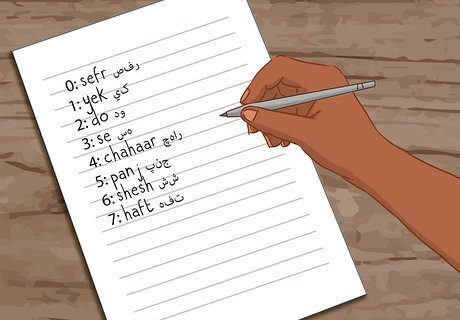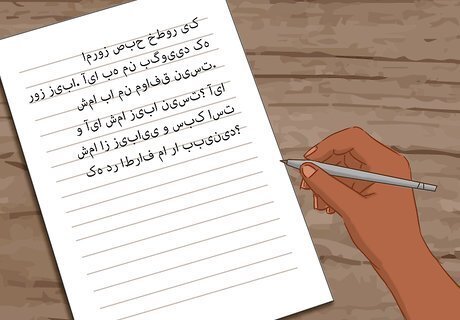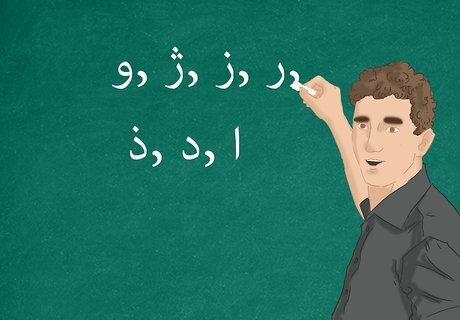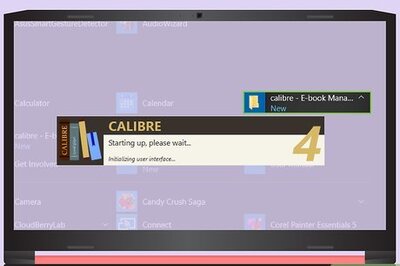
views
X
Research source
Speaking in Persian

Learn key phrases. To learn basic vocabulary in context, and to get a sense of how the language fits together, study phrases that you will commonly use when speaking Persian. Learning words in the context of sentences and conversation helps you retain them. To greet someone, say Hi: Dorood درود or Salam سلام, Welcome!: Khosh Amadid! خوش آمدید, How are you?: haleh shoma chetor ast?(formal) haletoon chetore?(informal) /حالتون چطوره؟ حال شما چطور است, Good morning!: Sobh Be kheyr ! صبح بخیر, Good evening!: Asr be kheyr! عصر بخیر, and Good night!: Shab be kheyr! شب بخیر To bid someone adieu, say See you later!: Ba’adan mibinamet بعدأ میبینمت, or Goodbye!: bedrood بدرود. To be polite, say Thanks: Mamnoon ممنون or Merci (like the French), Bless you (to a sneeze): A’afiat basheh عافیت باشه, Excuse me,... (to make a request): Bebakhshid ببخشید, Excuse me! (to get by: Bebakhshid ببخشید, Sorry: Bebakhshid/Mota'assefam ببخشید, and no problem: Moshkeli nist/Eshkali nadare مشکلی نیست. Listen to recordings of key phrases to learn pronunciation.

Learn dates and times. Practice your days of the week, and learn words for year, month, and times of day. Notice that while the word for "day" is "Rooz," the days of the week do not include this word. Instead, they build numerically from the word "shanbe," "Saturday." "Sunday" translates as "1 Saturday," while Monday is "2 Saturday" (shanbe, yek(1) shanbe, do(2) shanbe, etc). Look up the words you learn, listen to recordings, and practice saying them. Learn the days of the week. Saturday: shanbe شنبه Sunday: yek shanbe یکشنبه Monday: doshanbe دوشنبه Tuesday seh shanbe سه شنبه Wednesday: chehār shenebeh چهارشنبه Thursday: panj-shanbeh پنج شنبه Friday: ādineh آدینه or jom'e جمعه Learn to speak about time. Yesterday: deeRooz ديروز Today: emRooz امروز Tomorrow: faRdā فردا Day: Rooz روز Night: shab شب Week: hafteh هفته Month: maah ماه Year: sāl سال Second: sāneeye ثانيه Minute: daqeeqe دقيقه Hour: sā'at ساعت Morning: sobh صبح Evening: 'asr عصر Noon: zohr ظهر Afternoon: ba'ad az zohR بعد از ظهر Midnight: nesf shab نصف شب Now: aknoon اکنون or hālā حالا Later: ba'dan بعداً

Count. Practice counting aloud. Listen to recordings of native speakers pronouncing the numbers so that you learn the right sound.
Reading and Writing in Persian

Learn to write the Persian alphabet and numerals. The Persian alphabet is 32 letters long. These characters are written right to left, as are all the words. The Practice writing and reciting the alphabet. Listen to recordings of native speakers reciting the Alphabet. Try to learn the intonation. Make flashcards with the Persian script and Romanization on one side, and the English letter on the other. Quiz yourself in idle moments. Numerals are written as they are in Arabic, except for 4, 5, and 6. Unlike letters, numerals are written left-to-right. If you plan to study or live in Tajikstan, learn to write in Cyrillic script instead.

Link most letters and words. When you write in Persian, link most of the letters. Persian script is a semi-cursive script. There are, however, exceptions. These letters " و, ژ, ﺯ, ﺭ, ﺫ, ﺩ, ﺍ" link to the letter that precedes them, but not to the letter that follows. Most letters in Persian have four forms: initial, medial, final, and detached. The form they take depends on their position in a word. "Initial" letters are the first letter of a word, and they connect to the letter that follows. "Medial" letters are attached on both sides to the letters in a word that come before or after them. "Final" letters are those at the end of a word. They tend to take on a tail, or be written slightly larger than the letters preceding them. "Detached" letters are letters that stand alone, as in the alphabet. The seven letters that do not link take only two forms, "final" and "detached."

Omit most vowels. In written Persian script, "short vowels" (a, e, o) are omitted. "Long vowels" (ā, ī, ū) are included. This makes many words appear identical when written. When you read Persian, you will have to decipher such words from their context. When vowels are indicated in writing, they are usually written with diacritics or combined consonants.
Taking Classes and Studying Abroad

Locate classes in your area. Search online for local classes. Check the listings at your local community colleges, language schools, tutoring centers, and community centers. Look for "Farsi" classes as well as "Persian," as the older name is still common in the United States. It may be easier to locate classes if you live in a city. If you live somewhere rural, your best bet may be to take classes online.

Get a tutor. When you are learning a language that is not commonly studied in your area, it can be easier to find a tutor than a class. Look up language schools and tutoring services in your area. Put up ads on craigslist and tutoring websites offering to pay for tutoring sessions. Check to see what other potential students are offering, as well as what local tutors of other languages are asking, and have that amount in mind if you get any offers. Try putting up flyers in places that Persian-speaking people might be, such as mosques and neighborhoods with Iranian, Tajik, Afghan, and other residents. If you know anyone who speaks Persian, ask if they or someone they know could tutor you. A Persian speaker who has teaching experience in other subjects might be excited to combine their skills. Ask a friend who speaks Persian to make a standing date with you to chat in Persian. Offer to pay. Consider taking calligraphy lessons.

Sign up for online classes. Consider paying for online classes if you can't find any in your neighborhood. Check the MOOC list, search language learning sites for free online tutorials, or locate a small online class or tutor who will speak to you over Skype or chat. A simple search should land you with multiple options, so be selective. Make sure you take a class with plenty of multimedia and audio components, as your listening comprehension is vital to your learning Persian. Opt for classes taught by native speakers with years of teaching experience.

Study abroad. Be cautious and strategic when going abroad to study Persian. Sadly, you run a risk traveling to any country where Persian is a primary language. If you are traveling to a country plagued by terrorism, violence, or the after effects of civil and international war, make sure you are traveling to a city or town that is considered lower risk. Consider the areas that you must pass through, however, to get there. The organization that you travel with should discuss safety with you extensively. Consider a critical language scholarship. If you are an undergraduate or graduate student and a citizen of the United States, you might qualify for a CLS, an all-expenses paid intensive summer class run by the United States government. For Persian, you'll need to have studied for at least a year before this program will accept you. Visit a website like goabroad.com to find out about vetted study abroad opportunities. Check that any program you choose is run by legitimate organizations, such as certified colleges and universities. Places such as Afghanistan are high risk by various governments for terrorism, armed conflict, and violence. The borders and many areas of Tajikistan and Uzbekistan are considered high risk for terrorism, armed conflict, and land mines. Consider signing up for a Persian class in a country where Persian is not the primary language, but where there are cities with Persian-speaking neighborhoods.

Study by immersing yourself in Persian-language culture. Find Persian television shows and movies online. Watch with subtitles on if there is a an option to do so. Pick a regular podcast and follow it regularly. Look to prominent online book retailers to find Persian-language books, children's books, and comic books. Study poetry and learn famous verses. Poetry is a popular art in Persian-speaking countries, and famous poets such as Ferdowsi, Hafez, Rumi and Sa'di are quoted in everyday conversation. When buying books of Persian poetry, locate translated volumes with facing editions. That way, even as a new reader, you can read in English and refer back and forth with the original script. As with your classes, be sure to search for "Farsi" as well as "Persian." Consider taking calligraphy lessons. Sign up for classes online to learn a Persian art and practice your writing skills at the same time.

















Comments
0 comment